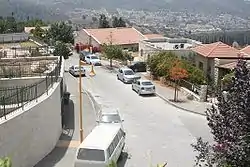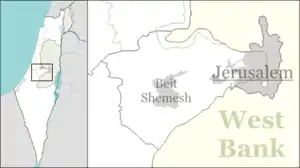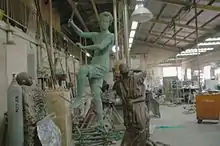Beit Nekofa
Beit Nekofa (Hebrew: בֵּית נְקוֹפָה) is a moshav in the Jerusalem District of Israel. Located in the Jerusalem Corridor, about 10 km west of central Jerusalem, next to Highway 1 and the Hemed Interchange, between Mevaseret Zion and Kiryat Ye'arim, south of Kiryat Anavim,[2] it falls under the jurisdiction of Mateh Yehuda Regional Council. In 2019 it had a population of 744.[1]
Beit Nekofa
בֵּית נְקוֹפָה بيت نكوفا | |
|---|---|
 | |
 Beit Nekofa  Beit Nekofa | |
| Coordinates: 31°48′10″N 35°7′31″E | |
| Country | |
| District | Jerusalem |
| Council | Mateh Yehuda |
| Affiliation | Moshavim Movement |
| Founded | August 1949 |
| Founded by | Immigrants from Yugoslavia |
| Population (2019) | 744[1] |
Etymology

Beit Nekofa's name may be based on the name of an ancient town, Nukveta (Hebrew: נוּקְבְתָא) of Benjamin, mentioned in the Talmud, from which the ancestors of Rabbi Judah haNasi are said to have come from. Nukveta is from the Hebrew word נִקְבָּה, Nikba, or tunnel.[3]
According to Zev Vilnay, Beit Nekofa was mentioned in the Jerusalem Talmud as the place of residence of a family of Kohanim. The Hebrew root of the name is Nakaf (נ-ק-פ, taken from Isaiah 17:6), referring to the collection of olives by means of hitting the tree, as opposed to harvest by hand (the Hebrew root Masak).[4]
In Arabic, Naqb means (mountain) passage. An Arab village, Bayt Naqquba, existed in the same location until the 1948 Arab–Israeli War when the area came under Israeli control and the villagers were expelled. After the end of the war, the residents were allowed to return and established a new village, Ein Naqquba, on the opposite side of Highway 1.[3][4][5]
History
Beit Nekofa was founded in August 1949 by seven families who immigrated to Israel from Yugoslavia. The Neveh Ilan-Beit Nekofa area was devastated by fire in the summer of 1996.[6] Two thousand dunams of forest and dozens of buildings in Kiryat Anavim and Beit Nekofa were destroyed or damaged in the blaze.[7]
Beit Nekofa runs a bronze foundry that employs many Arabs from the surrounding villages.[8]
References
- "Population in the Localities 2019" (XLS). Israel Central Bureau of Statistics. Retrieved 16 August 2020.
- Gold Atlas (Map) (2009 ed.). 1:100,000 (in Hebrew). Mapa. p. 32. § Het18. ISBN 965-521-082-0.
- HaReuveni, Immanuel (1999). Lexicon of the Land of Israel (in Hebrew). Miskal - Yedioth Ahronoth Books and Chemed Books. p. 126. ISBN 965-448-413-7.
- Vilnai, Ze'ev (1976). "Beit Nekofa". Ariel Encyclopedia (in Hebrew). Volume 1. Tel Aviv, Israel: Am Oved. p. 778.
- Morris, Benny (1994). 1948 and After: Israel and the Palestinians (2nd ed.). Clarendon Press. pp. 257-289. ISBN 9780198279297.
- MKs salute the trees The Jerusalem Post, 22 January 1997
- Report exonerates Fire Dep't The Jerusalem Post, 9 September 1996
- Give and Take The Jerusalem Post, 17 August 2001
